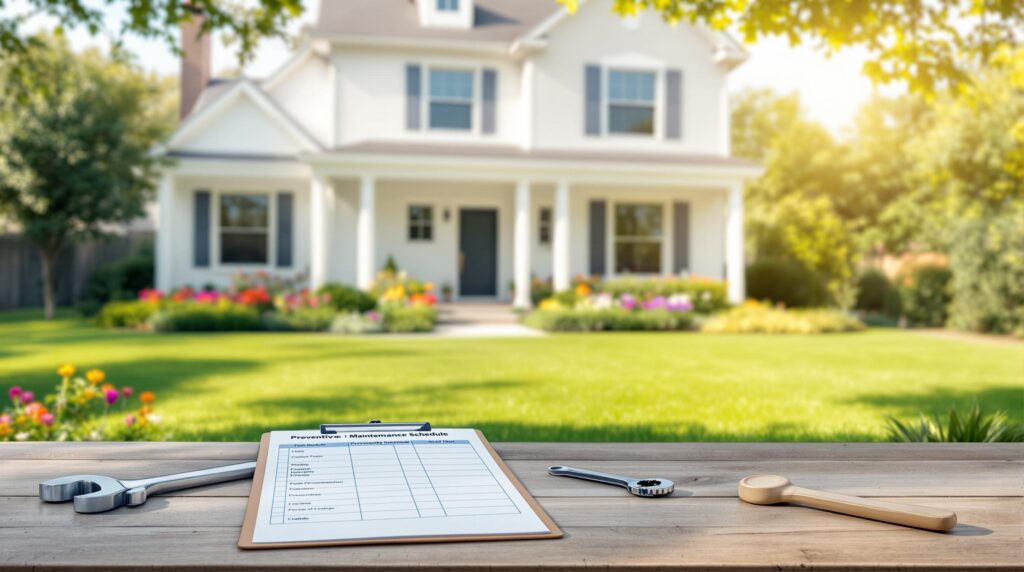
Rental Property Preventive Maintenance Schedule Guide
Preventive maintenance is essential for rental property owners to save money, extend the life of property systems, and keep tenants satisfied. Here’s a quick summary of what you need to know:
- Key Benefits: Fewer emergencies, longer equipment lifespan, lower costs, and happier tenants.
- Connecticut-Specific Tips: Prepare for seasonal weather (e.g., winterizing for frozen pipes, managing summer humidity) and follow state property maintenance codes.
- Maintenance Schedule: Regular tasks include:
- HVAC servicing (twice a year)
- Plumbing checks (annually)
- Roof and gutter inspections (spring and fall)
- Smoke/CO detector tests (yearly)
- Helpful Tools: Use digital platforms to track tasks, log repairs, and automate reminders.
A clear plan ensures your property stays in great shape year-round, avoids costly repairs, and complies with Connecticut laws. Let’s dive into the details!
Preventive Maintenance and Your Rental Property – How You …
Building a Maintenance Schedule
Creating a maintenance schedule ensures all property systems are addressed efficiently. A well-planned schedule not only helps avoid expensive repairs but also keeps tenants happy.
Types of Maintenance Tasks
Property maintenance tasks generally fall into four categories:
-
Routine Maintenance
These are regular tasks like changing HVAC filters, lawn care, and general cleaning. -
Preventive Maintenance
Scheduled inspections and services aimed at avoiding system failures. Examples include bi-annual HVAC servicing and yearly property inspections."I arrange to have an HVAC company service my rental properties twice a year. At that time, a technician checks the heating and air conditioning systems, changes the filters, and makes sure everything is working properly." – Laura Agadoni, Editor-in-Chief at Landlordology [3]
-
Seasonal Maintenance
Tasks tied to specific weather conditions, like cleaning gutters in spring and fall. -
Emergency Maintenance
Issues that need attention within 24 hours of being reported [3].
Using a detailed checklist can make managing these tasks much easier.
Property Systems Checklist
| System | Inspection Frequency | Key Tasks |
|---|---|---|
| HVAC | Twice yearly | Filter changes, system checks |
| Plumbing | Annually | Leak checks, water heater flush |
| Electrical | Annually | Smoke detector tests, outlet checks |
| Structural | Annually | Roof inspection, foundation checks |
| Exterior | Bi-annually | Gutter cleaning, siding inspection |
Schedule Management Tools
The right tools can simplify maintenance tracking, communication, and record-keeping:
-
Digital Tracking Systems
Online platforms allow tenants to submit maintenance requests, track work orders, log communications, and automate scheduling. -
Detailed Records
Keep thorough records of completed tasks, inspection results, repair histories, and contractor details.
For a more thorough approach, stagger maintenance dates every nine months. This allows you to assess the property during different seasons, helping to uncover seasonal issues and ensure year-round care [1].
Seasonal Maintenance Guide
Having a maintenance schedule tailored to the seasons helps keep your property in great shape throughout the year. Connecticut’s distinct seasons call for specific tasks to address weather-related challenges effectively.
Spring Tasks
Spring is the time to inspect for winter damage and prepare for warmer weather. Here’s what to focus on:
| Area | Tasks | Timing |
|---|---|---|
| Safety Systems | Test smoke and carbon monoxide detectors; replace batteries | Once per year |
| Building Exterior | Inspect the roof, clean gutters, check siding, and repair winter damage | Early spring |
| HVAC | Service the AC system and replace filters | Before summer arrives |
| Grounds | Repair lawn damage, fertilize, and aerate | Mid-spring |
| Plumbing | Check pipes for winter damage and inspect drainage systems | Early spring |
| Windows | Clean windows and replace any damaged screens | Mid-spring |
| Structure | Inspect sidewalks, stairs, and the foundation for cracks or wear | Early spring |
| Chimney | Schedule professional cleaning | Annually |
Summer Tasks
Connecticut summers, with average highs around 83°F, require a focus on keeping the property cool and prepared for sudden storms:
| Area | Tasks |
|---|---|
| AC System | Clean coils and drain pans; check belt tension for proper operation |
| Exterior | Inspect siding after storms and make repairs as needed |
| Drainage | Keep an eye on gutters and downspouts to ensure proper water flow |
| Landscaping | Maintain regular lawn care and trim overhanging branches or trees |
Fall Tasks
Fall is all about getting ready for the colder months ahead. Prioritize these tasks:
| System | Tasks | Timing |
|---|---|---|
| Heating | Clean and inspect the furnace to ensure it’s ready for winter | Early fall |
| Exterior | Clean gutters and inspect the roof for damage | Before leaves accumulate |
| Insulation | Check attic and wall insulation to retain heat | Mid-fall |
| Weatherproofing | Seal windows and doors to prevent drafts | Late fall |
These tasks help prepare your property for winter while improving energy efficiency.
Winter Tasks
When temperatures drop to an average of 20°F, winter maintenance focuses on safety and heating:
| Priority | Tasks |
|---|---|
| Safety | Remove ice and snow from walkways to prevent accidents |
| Heating | Monitor the heating system and inspect insulation for efficiency |
| Prevention | Keep an eye on drainage and take steps to avoid ice dams |
| Efficiency | Check weather stripping and ensure proper attic ventilation |
sbb-itb-66a7c69
Creating Your Maintenance Plan
Property Assessment Steps
Start by evaluating your property to identify its maintenance needs. Use this table to guide your assessments:
| System | Key Checks | How Often? |
|---|---|---|
| Structure | Inspect foundation, check for wall/ceiling cracks | Annually |
| Plumbing | Look for water damage, detect leaks | Quarterly |
| Safety | Test smoke/CO detectors, verify locks | Monthly |
| HVAC | Test system efficiency, inspect filters | Twice a year |
| Exterior | Inspect roof, check gutters | Spring/Fall |
Task Planning and Timing
Plan maintenance tasks based on urgency and seasonal factors. Emergency repairs need immediate action, while preventive measures can be scheduled in advance. A well-organized plan keeps everything running smoothly.
| Priority | Time Frame | Examples |
|---|---|---|
| Emergency | Within 24 hours | No heat, major leaks, electrical failures |
| Urgent | Within 48 hours | Minor plumbing issues, appliance repairs |
| Routine | 1-2 weeks | Filter replacements, general inspections |
| Preventive | Seasonal | HVAC servicing, gutter cleaning |
After scheduling tasks, assign clear responsibilities for seamless execution.
Maintenance Team Roles
Assigning specific roles ensures every aspect of maintenance is handled effectively.
Property Manager Responsibilities:
- Schedule and coordinate maintenance tasks
- Manage emergency responses
- Oversee contractor performance
- Communicate with tenants about maintenance updates
Contractor Duties:
- Handle specialized repairs and maintenance
- Conduct scheduled inspections
- Record completed work
- Offer expert advice on property upkeep
Tenant Responsibilities:
- Report maintenance issues promptly
- Keep the property clean
- Use appliances and fixtures properly
- Allow access for scheduled maintenance
Once roles are defined, focus on documenting all activities for future reference.
Record Keeping System
A reliable tracking system helps you stay organized. Here’s what to include:
| Documentation Type | What to Track | How Often? |
|---|---|---|
| Maintenance Logs | Date, task details, costs | After each service |
| Inspection Reports | Condition notes, photos | Quarterly |
| Service Records | Contractor info, warranties | After each service |
| Cost Tracking | Expenses, budget comparisons | Monthly |
Keep digital copies of all records, including photos, receipts, and warranties, for easy access and long-term reference.
Connecticut Laws and Requirements
Understanding and following Connecticut’s strict property maintenance laws is essential to safeguard your investment and avoid potential legal issues.
State Property Standards
Connecticut law requires property owners to keep essential systems and common areas in good condition to ensure tenant safety. For example, heating systems must work properly during cold weather, and common areas must be safe and free of hazards. Property owners are also responsible for clearing snow and ice promptly to prevent accidents and potential legal claims [4].
Weather Protection Methods
Connecticut’s unpredictable weather demands that property owners take proactive steps to ensure safety. This includes clearing snow and ice from walkways and shared spaces as soon as possible. Regularly checking weather forecasts and taking preventive measures can help reduce risks and ensure compliance with state regulations.
Staying on Top of Legal Deadlines
While Connecticut law doesn’t provide exact deadlines for every maintenance task, having a consistent schedule for inspections and repairs is critical. Keep detailed records of all maintenance activities to show compliance and protect yourself from liability. A well-documented approach can make a big difference in meeting legal expectations.
Maintenance Management Tools
Once your maintenance schedule is set, having the right tools in place can make a big difference in execution and record-keeping. Modern tools simplify the process and help keep properties in good condition.
Schedule Templates
Key tasks include changing HVAC filters every three months (or at least twice a year), flushing water heaters twice annually, testing smoke and CO detectors yearly, and inspecting common areas regularly. For properties in Connecticut, templates should also incorporate state-required tasks, including a 24-hour response window for emergencies and a 24-48 hour window for standard repairs [3].
Software Options
Maintenance management software can automate many routine tasks, saving time and effort.
"Maintenance shouldn’t mean guesswork and paperwork. UpKeep makes it simple to see where everything stands, all in one place. That means less guesswork and more time to focus on what matters."
One option is HomeManager, which offers a free basic plan and a Plus version for $8/month or $80/year. Features include:
- Automated maintenance reminders
- DIY video libraries
- Digital maintenance logs
- Work order tracking
- Mobile access
Maintenance Checklists
Detailed checklists work hand-in-hand with your schedule, ensuring inspections are thorough. Here’s a breakdown of tasks by frequency:
| Timeframe | Essential Tasks |
|---|---|
| Monthly | Check common area lighting, verify security systems, maintain garbage areas |
| Quarterly | Replace HVAC filters, inspect plumbing, clean drains |
| Semi-Annually | Flush water heaters, clean gutters, inspect exteriors |
| Annually | Conduct full property assessments, test smoke/CO detectors, service appliances |
These tools and checklists help you stay organized, meet compliance requirements, and stick to repair schedules effectively.
Summary
Having a preventive maintenance schedule in place is essential for safeguarding your rental property investment and keeping tenants happy. Regular maintenance helps catch problems early, avoids expensive emergency fixes, and keeps property systems running longer.
A structured maintenance plan works best. Here’s a breakdown of what to include:
| Component | Key Tasks | Suggested Frequency |
|---|---|---|
| Interior Systems | Replace HVAC filters, test smoke and carbon monoxide detectors, inspect appliances | Quarterly/Annually |
| Exterior Elements | Clean gutters, inspect the roof, check siding | Semi-annually |
| Documentation | Keep maintenance logs, repair records, and inspection reports | Ongoing |
Experts suggest inspecting the property at least once a year, though a nine-month rotation is often recommended to address seasonal wear and tear [1].
Good communication with tenants is just as important. Digital tools can streamline maintenance requests and help schedule routine tasks effectively. Focus on high-risk areas like bathrooms and kitchens, where unchecked leaks can lead to costly repairs [2].



